HOW TO HAVE A RESPONSIBLE SNORKELING EXPERIENCE IN THE MALDIVES

Not surprisingly, snorkeling tours and diving are among the top things to do in the Maldives. The nation consists of 22 atolls and over 1,200 coral islands, making its captivating underwater world naturally spectacular. All resorts offer snorkeling. However, if you choose one that has an accessible house reef, you’ll be able to go directly from the beach rather than on a prearranged boat trip. If you’re travelling on a budget, stay on a local inhabited island at a guesthouse or hotel that specializes in scuba diving. You’ll save a bundle on accommodations but be taken to the same sites as resort guests.
Exploring the mesmerising wonders of the underwater world is vital to unravelling the Maldives’ beauty. We firmly believe that for tour operators and travelers, it is crucial to embrace responsible practices and acquire knowledge to safeguard conservation, particularly coral reefs in the Maldives. This understanding empowers you to make conscientious decisions, minimizing your impact on delicate marine habitats and ecosystems.
At Secret Paradise Maldives, we prioritise marine conservation and responsible snorkeling experiences. In close collaboration with Green Fins, we are committed to ensuring that all our guests are well-informed about marine safety protocols before entering the water. We place a strong emphasis on the certification of our snorkeling guides through Green Fins, guaranteeing that they possess the necessary knowledge and expertise in sustainable practices. By incorporating Green Fins’ guidelines into our operations, we aim to provide you with unforgettable underwater adventures while decreasing our impact on the delicate marine ecosystems of the Maldives.
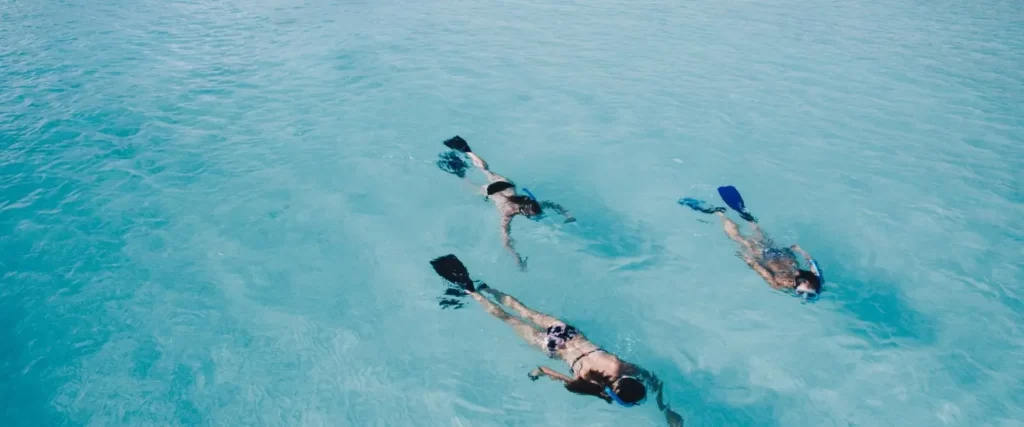
WHO ARE GREEN FINS?
Green Fins is an organisation on a mission to protect and conserve coral reefs through responsible and sustainable snorkeling and diving practices. Their aim is to educate and train dive and snorkel operators on environmentally friendly techniques. By promoting proper buoyancy control, responsible behaviour around marine life, and minimising damage to coral reefs, Green Fins seeks to reduce the impact of these activities on fragile ecosystems such as the Maldives. Through their collaborative efforts, they strive to create a global community of environmentally conscious snorkelers and divers who actively contribute to the preservation of our oceans for future generations.
HOW TO CHOOSE SNORKEL EQUIPMENT?
We often get asked ‘Do I need to pack snorkel, mask and fins?’ Whilst we do provide equipment on all our tours where we are snorkeling and snorkeling equipment will also be available to rent at resorts and guesthouses, we would advise to bring along your own mask and snorkel.
Not only will you be assured the mask fits your face properly and is comfortable and less likely to have leakage, it will also lower any health associated risks. We find that peace of mind goes a long way. A mask and snorkel is small and light and should take up very little space in your suitcase.
Fins which are the cumbersome part are available to rent or if you have booked a snorkeling tour with us will be included within the package. Whilst renting or using fins we supply means you won’t have to try and find room for them in your bag and leaves you space for other essentials it may also mean that we are unable to provide a 100% comfortable fit. If snorkeling is going to form a large part of your holiday, then the comfort of your equipment will also add to your overall enjoyment of the activity.
Snorkeling mask:
This is a basic element, the convenience of which does not depend on the cost. There are both expensive and cheap brands that are not very different in quality. Of course, in order to choose the mask that suits you, you need to try it on. That is, inhale through your nose and remove the hand that pressed the mask to your face. The size that suits you will not slip.
A good mask must have:
- “Tempered” text on the glass (or simply T). This means that the portholes of the mask are made of tempered glass.
- Elastic seal. The edges of the mask should fit snugly against the face.
- Wide view. To do this, choose a mask with an obturator made of transparent silicone. The coloured border will distract you and limit your view.
- Small internal volume.
To prevent the mask from fogging up during swimming, the inside of the glass is treated with a special agent – anti-fog before use. On the advice of experienced swimmers, you can simply smear the glasses with saliva.
Snorkeling tube:
An equally important attribute for snorkeling. You can also swim with a mask, holding your breath while diving. Nevertheless, a tandem mask plus a snorkel helps to maintain strength. The tube should not be too long – this makes breathing difficult. However, a snorkel that is too short will be difficult to manipulate when diving. Choose the middle tier.
*Important! You can choose a snorkel for yourself with a special purge valve. It pushes out water that gets into the tube when splashed. The second option is a tube with a removable nozzle. In any case, it is worth checking everything so that there are no difficulties with breathing already while swimming.
Fins:
Flippers or the correct term ‘fins’ are not always required, especially in shallow water. Fins are needed for easier maneuverability in the water. They increase speed and maintain strength during the dive and ascent. Choose fins that are not very long and light, which will not weigh down your legs. Good diving fins can work for snorkeling too.
Due to the ocean current and wind conditions in the Maldives, the use of fins is essential in almost all snorkeling locations and especially during pelagic marine life encounters where you will be surprised at the speed a whale shark can swim! We understand that you may have snorkeled elsewhere in the world without fins, but they are a necessity in the Maldives to make the most of your experience.
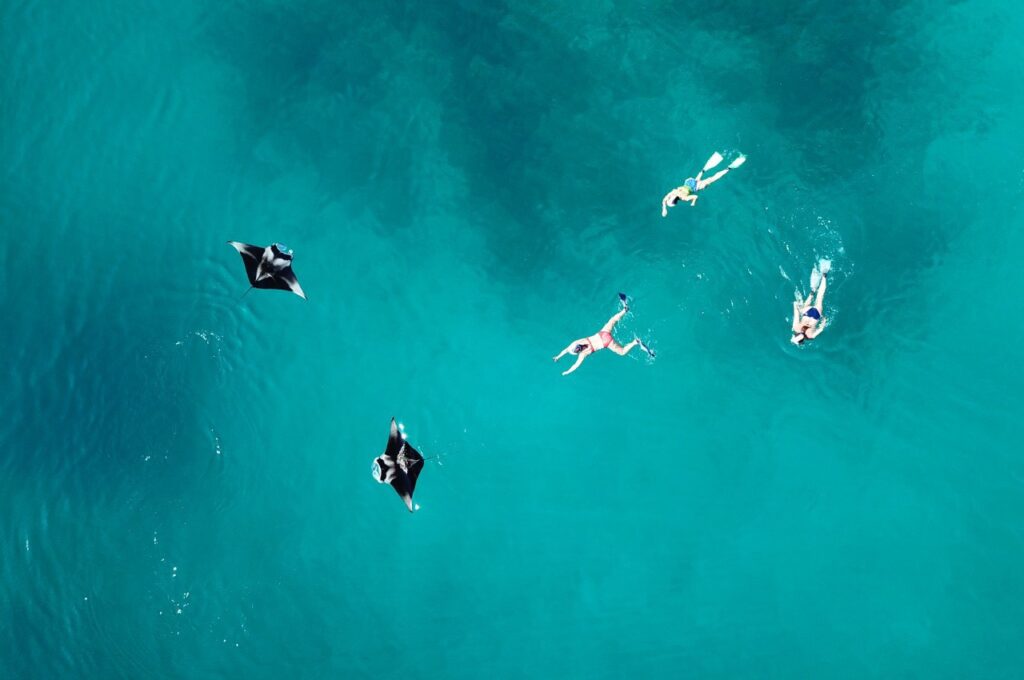
WHAT MARINE LIFE WILL YOU USUALLY ENCOUNTER?
When you first put on your mask and immerse your face in the crystal-clear waters of the Maldives, a whole new world of marine life will unfold before your eyes. Almost all resorts in the Maldives are located either close to a reef or is itself located in an extensive lagoon or a combination of both. This makes snorkeling very easy and the most popular water activity. The visibility in the Maldives is fantastic. The year-round water temperature is 27 to 30 degrees Celsius.
Renowned as one of the world’s premier snorkeling destinations, the Maldives offers numerous reasons for its allure:
- Turtles: Despite being endangered, the Maldives is home to a significant population of turtles, particularly in Lhaviyani Atoll. At Kuredu Caves, you can snorkel with the largest community of Green Sea turtles, while Innahura provides an opportunity to observe Hawksbill turtles at Turtle Rock. We actively collaborate with the Olive Ridley Project, dedicated to researching and safeguarding turtles in the region.
- Rays: Graceful and awe-inspiring, rays of various shapes and sizes inhabit the Maldivian waters. Snorkelers have the privilege of encountering stingrays gliding gracefully in the sand, eagle rays soaring by, and majestic manta rays either feeding or visiting cleaning stations.
- Fish: The vibrant and kaleidoscopic colours of tropical fish will leave you mesmerised as you explore the underwater wonders of the Maldives. Witness schools of blue-striped snappers moving in perfect unison, and encounter clouds of dazzling fusiliers that engulf you in a mesmerising sea of fish. Keep an eye out for the adorable clownfish residing in anemones, giving you a chance to find your own “Nemo.” Delicate butterfly fish, iridescent unicorn fish, and imposing Napoleon wrasse gracefully cruising by are just a few of the countless species you can encounter.
- Moray Eels: Normally shy and hidden within reef crevices, moray eels sometimes venture out in search of a delectable fish meal. Keep an eye out for giant morays with their heads protruding from the reef, opening and closing their mouths, and the striking honeycomb morays sporting vivid yellow and black markings.
- Sharks: Snorkelers in the Maldives frequently encounter black-tip reef sharks, while nurse sharks and leopard sharks can also be observed resting on the reef. The Maldives is also renowned for providing an opportunity to witness the impressive whale sharks, the largest fish in the sea, reaching up to 12 meters in length. These gentle giants are a “must-see” for both snorkelers and scuba divers alike.
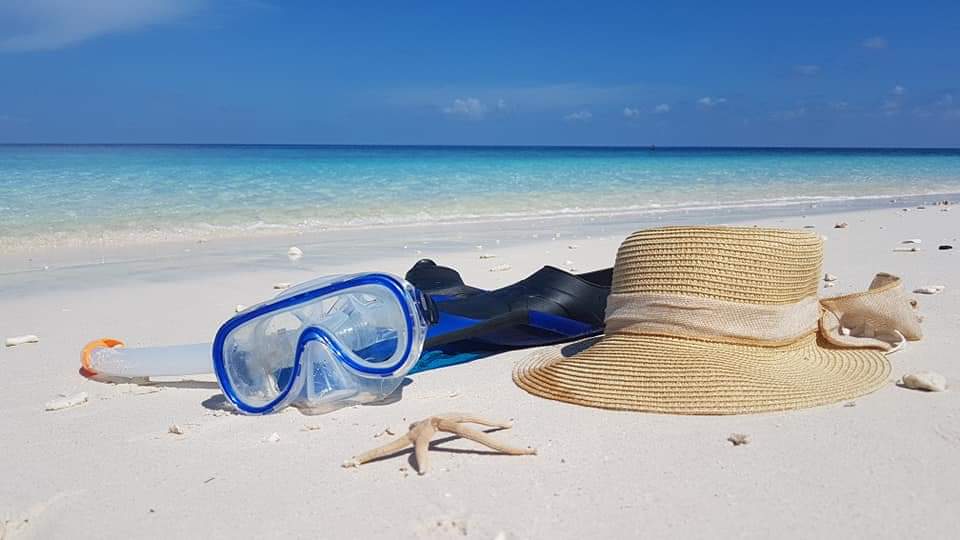
TIPS FOR RESPONSIBLE SNORKELING
When it comes to marine life interactions, there are clear do’s and don’ts. We should all be mindful not to damage, touch or harass underwater life, yet some choose to treat the underwater world like a petting zoo. We wanted to review some essential guidelines for marine life encounters.
- DON’T: Ride, Touch or Stand On Marine Life
The ocean is not a dude ranch. Whale sharks, turtles, and other pelagic aren’t domesticated animals. Instead, they are sensitive creatures that humans can easily injure.
- DO: Keep off the Bottom
Avoid stepping on stingrays and other fragile marine life by keeping off the bottom. Mind your fin kicks to avoid disturbing animals, stirring up silt, kicking coral, and annoying other snorkelers.
Avoid touching coral whenever possible, and be careful when finning near a reef. Some corals grow only .07 inches (2 centimeters) or less per year. An accidental kick or pinched-off branch can instantly destroy 50-100 years of growth.
- DON’T: Chase Marine Animals
There is one thing nearly every topside or underwater creature has in common: they run away when chased. Chasing after animals can stress them out, and alter natural behaviour patterns. If a turtle, fish, octopus, or other critter is frightened, simply back off, lie low and be still. If the animal is curious enough, it might come out of hiding.
Chasing the animal is an excellent way to ensure you’ll never see it again. But, conversely, the best way to get close to marine life is to learn about its behaviour.
- DO: Keep Your Hands to Yourself
There are so many reasons to not touch animals while snorkeling. In addition to being potentially harmful, some underwater creatures have layers that protect them from infection. For example, some rays have a protective mucus coating. The oils from our fingers can wear away the layers and leave animals vulnerable. Additionally, touching corals can cause stress and bleaching. And if that wasn’t enough, underwater animals can be more delicate than we think. Don’t risk it, now knowing your strength. More information can be found here, in our article Look but Don’t Touch.
- DO: Take Only Photos, Trash, and Good Memories!
Remove and report any debris you find underwater as this will help conservationists and scientists pinpoint problem areas and advocate for positive change. Do not remove seashells or other tokens from the ocean. Removing shells can negatively impact the ocean by decreasing the number of essential chemical compounds and the number of animals that rely on shells.
- DON’T: Feed the Fish
A juvenile whale shark eats 46 pounds (20 kilograms) of plankton per day, and certain nudibranchs can eat fire coral, but neither of these diets would be good for a human. So just as it’s a bad idea for humans to eat fish food, it’s bad for fish to eat human food. More information can be found here in our article 5 Reasons not to Feed Marine Life.
- DO: Be a Voice for the Ocean
Share what you know about the ocean and responsible marine life interactions with people who don’t. Use your experience to educate others about how important the ocean is, and what we can do to protect it.
- DON’T: Be a Bystander
If you see something, say something. For example, if you observe another snorkeler acting carelessly, or posting inappropriate behaviour on social media, remind them of their responsibility to be an underwater steward.
- DO: Choose a Responsible Operator
Seek out snorkeling operators and destinations that protect local marine life. There is a code of conduct for interacting with almost all marine life. If you find an operator who posts images of divers/snorkelers handling animals, tell them they will not receive your business because of their disrespectful practices.
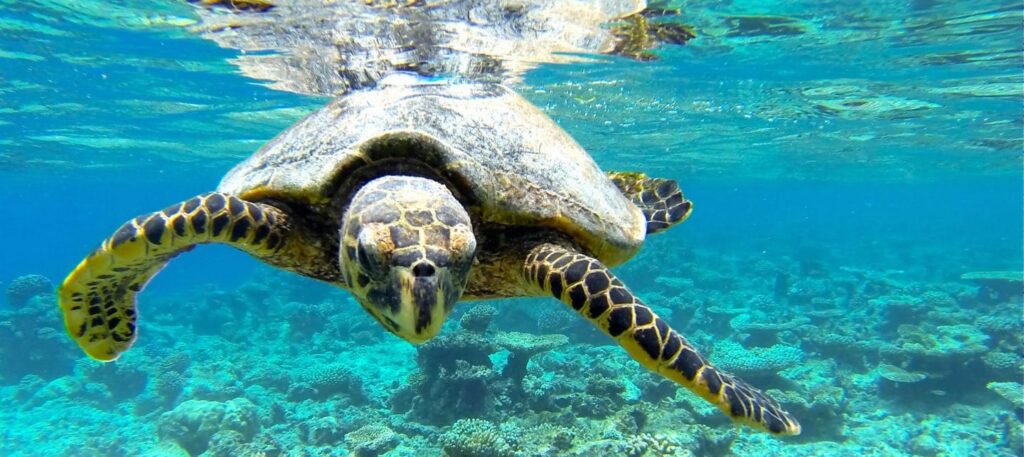
WHAT ARE THE SAFETY PROTOCOLS OF SNORKELING?
Before you go swimming and snorkeling, please note the following safety tips to ensure your adventures in the ocean are both fun and safe:
- Fins are a must if snorkeling and advised if swimming out of your depth. You may encounter ocean currents and fins will make it much easier to swim in the desired direction.
- Never snorkel alone – for your safety, find a snorkel buddy or join our guided activities.
- Keep an eye on the shore to ensure you’re not drifting too far away.
- If you’re going for a swim, stay close to shore, ensure your feet can touch the bottom and have a buddy onshore looking out for you.
- Do not go for a late-night dip on your way back from the bar – it might seem like a great idea at the time but judgement might be impaired by the darkness…and perhaps the cocktails!
- Don’t pick anything up from the sandy bottom or the coral reef – it’s safer for you, and whatever you’ve seen to simply look and admire.
- Wear sun protection – the sun is very strong when you’re this close to the Equator and you won’t realise you are burning while in the water. We recommend ‘Reef Safe’ sunscreen to help look after the health of our oceans, sun protective swimwear and rash guards are a great way of reducing the need for sunscreen too.
- Pop along to the Dive Centre and find out about the local conditions and you’ll get some really good advice on the places to swim and practice snorkeling, as well as any areas to avoid due to the potential for strong currents.
- Marine life in the Maldives is incredible with an abundance of colourful fish to watch and turtles, sharks and rays too. There’s no need to be afraid of any of it – the sharks are not interested in humans and stingrays actively move away if they sense you getting too close, in fact, you’ll have to purposefully sneak up on them if you want a good picture!
- Most importantly…enjoy and have fun!
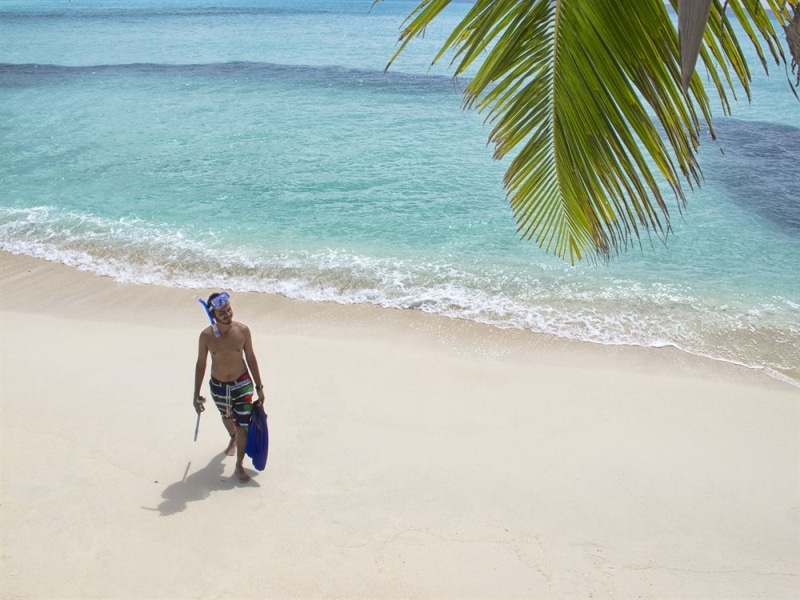
In conclusion, embracing responsibility as snorkelers and divers is not only a privilege but a duty we owe to the mesmerising underwater world. By prioritising sustainable practices, such as respecting marine life, avoiding damage to coral reefs, and reducing our carbon footprint, we can contribute to the long-term preservation of these precious ecosystems. Let us be mindful of our actions, educate ourselves about the fragility of marine environments, and inspire others to join us in protecting the breathtaking beauty that lies beneath the surface. Together, we can ensure that future generations will continue to revel in the wonders of the underwater realm for years to come.
Join us for a week of snorkeling adventure in North Ari Atoll. Tailored for snorkeling and marine life enthusiasts and those eager to enhance their knowledge of the marine environment. Immerse yourself in crystal-clear waters and explore the vibrant coral reefs, where a rich tapestry of marine life awaits. Get up close and personal with graceful manta rays, gentle turtles, and mesmerizing reef sharks. Connect with this magical underwater world, while gaining valuable insights into the delicate balance of our ecosystem and the importance of preserving it. Prepare for awe- inspiring moments and an educational journey that will leave an indelible mark.